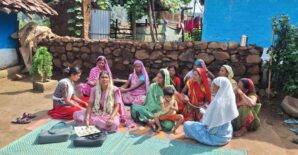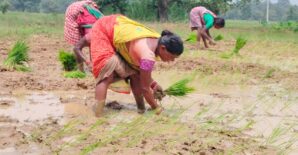Livestock sector, an important source of livelihoods for rural India, has been severely hit by the COVID-19 lockdown. In addition to lockdown induced supply chain disruptions, the sector has also suffered from the rumours of animal to human transmission of coronavirus, reduction in demand due to income loss, and collapse of exports. Anjani Kumar, Chandra Sekhara Rao, and Raka Saxena present available evidence and share their insights about the way forward -Shahidur Rashid, series co-editor and Director, International Food Policy Research Institute, South Asia.

Himachali woman milking a cow in Shimla, Himachal Pradesh, India before the Covid-19 pandemic. Shutterstock/Dushi82
The COVID-19 pandemic has afflicted public health systems worldwide, and policymakers across the globe are focusing on effective containment of this deadly virus. To prevent the spread of this pandemic within communities, the Government of India announced a 21-day lockdown on March 23, which has been extended thrice already – the country is now under lockdown phase 4.0 till May 31. This lockdown has already disrupted supply chains and is likely to completely change the landscape of economic activities, including food production, processing, distribution and trade, and consumption. A significant shock to the economy, the lockdown will hurt every sector, though with varying magnitude and intensity. Livestock sector, in particular, is confronted with both unprecedented demand and supply shocks. The effects of COVID-19 on the sector, though yet to be quantified, is expected to be one of the worst hit sub-sectors because of the perishability of its products.
Impact on livestock and livelihoods
About 102 million agricultural households (70% of the total) derive supplementary income from livestock, and 22 million agricultural workers are engaged primarily in rearing some species of livestock.i Crop output is subject to climate and market uncertainties, and millions of farmers mitigate this risk by turning to the livestock sector. This enhances food and nutritional security and agricultural growth, reduces rural poverty, and mitigates the vulnerability of farm households to agricultural production shocks. The importance of livestock sector has been significantly on the rise, with 27% contribution to the gross value added (GVA) in agriculture and growing by over 6% annually. But the lockdown has undermined its dynamism.
Collapsing consumption of poultry and dairy goods
Livestock products are an important component of diet and its share in food expenditure has been continuously increasing. As per the latest consumption survey, these products, on an average, account for about 34% of the food expenditure in Indiaii.
COVID-19 has disrupted the consumption of some of the livestock products.iii The poultry industry has been severely hit in the country, with poultry shops shutting down due to limited consumption caused by misconceptions of transmission of virus from animals to humans, and restrictions on inter-state movement. Due to drastic fall in the demand of poultry meat and eggs, chicken prices have sharply dropped at the farmgate to 60% below cost of production. The Ministry of Animal Husbandry, Dairying and Fisheries has estimated that the industry was losing Rs 1,500-2,000 crore daily during February and early March.iv
Low consumption of milk products due to the lockdown, largely due to supply and demand issues, has also been of serious concern. India produces about 560 million litres of milk daily, of which 310-315 million litres becomes available in the market.v In many regions, large, organized networks of cooperatives procure milk from dairy farmers. Nationally, dairy cooperatives procure about 51 million litres of milk per day, and the organized private sector and informal milk market agents manage the rest. The lockdown has disrupted these formal and informal dairy supply chains and jeopardized small farmers, leading to sudden jerks in prices. Most dairies in the organized private sector have stopped procuring milk. Cooperatives have also started announcing milk holidays. Hotels, restaurants, caterers, and even tea shops are closed, depressing milk sales further. These segments account for about 30% of total milk consumption in North India. During the lockdown, milk demand has reduced by 20-25%,iii and the milk business lasts for only a few hours each day. If this market uncertainty continues, producer prices will be depressed, and losses will limit the possibility of ploughing capital back into the farm livestock business. Disruptions to on-farm labour have also upset the milk supply chain, and disposal of surplus milk has become a recurring issue.
Disruptions in supply chains of feed industry
The INR 350 billion worth feed industry is reeling under unprecedented crisis as it continues to face the aftermath of restrictions on logistics imposed under the lockdown. In addition, the prices of raw materials, primarily soya meal, have gone up by nearly 10-15% during Apriliv, which could be because of low supply caused by fewer plants in operation. The problem for the industry has compounded as additional costs of logistics and raw material cannot be passed on to the end users, vis-a-vis the farming community engaged in rearing of cattle, poultry and fisheries.
Disruption of logistics, especially shortage of raw materials and delivery problems, is a much acute problem for the livestock sector than crop agriculture. Feed shortages mean that animals and poultry are likely to starve to death. This is because there are short production cycles and animals need to eat every day for successful completion of this cycle. For instance, the production cycle for dairy is on a daily basis, and six weeks for chicken. Animal health services, that are already limited in the country, have been further affected in several places as most of the resources are being diverted for prevention, diagnostics and minimization of COVID-19 impacts. It is worth mentioning that in a usual scenario, one veterinarian has to take care of about 7000 cattle or buffalo.
Sagging exports
India is the second largest bovine meat exporter worldwide, with an annual exports of buffalo meat worth US$ 3,610 million. The exporters have been severely affected, with no fresh orders from key markets for import of buffalo meat. During April 2020, there has been about 56% reduction in export of livestock products. Prices are falling as exports have dried up with contracting export demand. Availability of containers and higher freight rates have been some of the major challenges as trucks and manpower are not available to transport shipments. Another common challenge faced by the exporters is in dealing with demands from importers to declare their products not infected by coronavirus.
Way forward
Recovery from the crisis is as important as managing the health crisis arising out of coronavirus. In such situation, it is the ultimate goal of any government to meet the food and nutritional needs of vulnerable sections of the population. The government has expanded emergency food assistance and enhanced the safety nets by extending free ration for three months, direct cash transfers, food camps offering regular meals to daily wage earners and other vulnerable communities. However, the safety nets did not address concerns of the livestock sector so far.
The recent announcement to give a boost to livestock sector is a welcome step. Yet, a lot of efforts are needed to revive this sector, which can be used as an opportunity to improve the entire value chain. For instance, the ground-level institutional credit to livestock sector is only about 5% of the total agricultural credit. A huge push is needed to enhance the flow of institutional credit to livestock sector. Easy availability of credit for livestock may encourage the migrants who have returned home to be engaged in the dairy farming or other livestock opportunities. Through formalization of micro food enterprises, more emphasis should be given to livestock sector. Additionally, a cluster approach must be vigorously pursued for dairy, poultry, piggery, etc. based on the regional comparative advantage.
COVID-19 has increased awareness among people on the need to adopt a healthy diet and inculcate hygienic practices. Awareness on healthy diet can spur demand for livestock products and can thus prove to be a good opportunity to expand business of livestock farmers. Several studies conducted by International Food Policy Research Institute (IFPRI) indicate that there is a lack of adequate food safety measures across the value chain and only 29-44% of the recommended practices are being adopted by the dairy farmers at the farm-levelvii. Compliance with food safety measures will need more attention in the post-COVID-19 period. Similarly, we need to move-up the value chain. More emphasis needs to be given for creating facilities for processing at a more disaggregated level, which would have helped to mitigate the disruption of sales of liquid milk in the rural areas. Any compromise on feeding and health of animals would negatively impact the reproduction efficiency and productivity. We need to strengthen the delivery mechanisms, both at the input and output level.
Anjani Kumar is Research Fellow at IFPRI, Chandra Sekhara Rao Nuthalapati is Professor of Economics, Institute of Economic Growth, New Delhi. Raka Saxena is Principal Scientist, Agricultural Economics, ICAR-National Institute of Agricultural Economics and Policy Research, New Delhi.
This blog has been published as a part of the International Food Policy Research Institute (IFPRI), South Asia, blog series on analyzing the impacts of the COVID-19’s pandemic on the sub-national, national, and regional food and nutrition security, poverty, and development. To read the complete blog series click here
[i] Employment and unemployment survey of the National Sample Survey Office (NSSO), 68th round, MOSPI, New Delhi
[ii] Consumption Expenditure Survey of the National Sample Survey Office (NSSO), 68th round, MOSPI, New Delhi
[iii] Atma-Nirbhar Bharat (Self-Reliant India)-Part3-Agriculture, FM Announcement on 15th May 2020
[iv] Economic Times, 9 March, 2020
[v] www.NDDB.Coop and BAHS, GoI
[vi]Several newspapers
[vii] Kumar A, Mishra AK, Saroj S, Sonkar VK, Thapa G, Joshi PK. Food safety measures and food security of smallholder dairy farmers: Empirical evidence from Bihar, India. Agribusiness. 2020;1–22. https://doi.org/10.1002/agr.21643
Anjani Kumar, Iain A. Wright & Dhiraj K. Singh (2011): Adoption of Food Safety Practices in Milk Production: Implications for Dairy Farmers in India, Journal of International Food & Agribusiness Marketing, 23:4, 330-344. http://dx.doi.org/10.1080/08974438.2011.621855
New research from a Special Issue of Applied Economic Perspectives and Policy
The pandemic caused disruptions to both the supply of and demand for health services that persisted past the lifting of lockdown measures.
Public food transfer programs have traditionally been the most common social protection programs in Bangladesh



